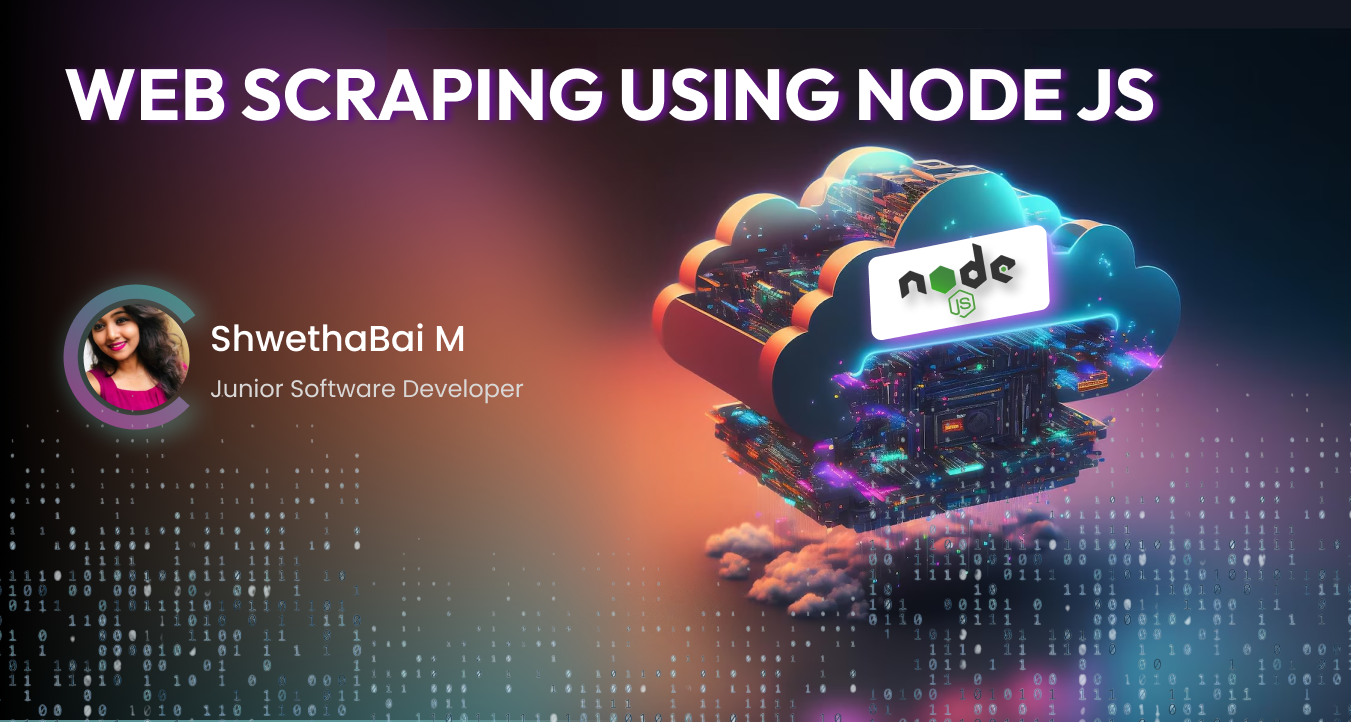Web scraping using node js is an automated technique for gathering huge amounts of data from websites. The majority of this data is unstructured in HTML format and is transformed into structured data in a spreadsheet or database so that it can be used in a variety of applications in JSON format.
Web scraping is a method for gathering data from web pages in a variety of ways. These include using online tools, certain APIs, or even creating your own web scraping programmes from scratch. You can use APIs to access the structured data on numerous sizable websites, including Google, Twitter, Facebook, StackOverflow, etc.
The scraper and the crawler are the two tools needed for web scraping.
- The crawler is an artificially intelligent machine that searches the internet for the required data by clicking on links.
- A scraper is a particular tool created to extract data from a website. Depending on the scale and difficulty of the project, the scraper's architecture may change dramatically to extract data precisely and effectively.
Different types of web scrapers
There are several types of web scrapers, each with its own approach to extracting data from websites. Here are some of the most common types:
- Self-built web scrapers: Self-built web scrapers are customized tools created by developers using programming languages such as Python or JavaScript to extract specific data from websites. They can handle complex web scraping tasks and save data in a structured format. They are used for applications like market research, data mining, lead generation, and price monitoring.
- Browser extensions web scrapers: These are web scrapers that are installed as browser extensions and can extract data from websites directly from within the browser.
- Cloud web scrapers: Cloud web scrapers are web scraping tools that are hosted on cloud servers, allowing users to access and run them from anywhere. They can handle large-scale web scraping tasks and provide scalable computing resources for data processing. Cloud web scrapers can be configured to run automatically and continuously, making them ideal for real-time data monitoring and analysis.
- Local web scrapers: Local web scrapers are web scraping tools that are installed and run on a user's local machine. They are ideal for smaller-scale web scraping tasks and provide greater control over the scraping process. Local web scrapers can be programmed to handle more complex scraping tasks and can be customized to suit the user's specific needs.
Why are scrapers mainly used?
Scrapers are mainly used for automated data collection and extraction from websites or other online sources. There are several reasons why scrapers are mainly used for:
- Price monitoring:Price monitoring is the practice of regularly tracking and analyzing the prices of products or services offered by competitors or in the market, with the aim of making informed pricing decisions. It involves collecting data on pricing trends and patterns, as well as identifying opportunities for optimization and price adjustments. Price monitoring can help businesses stay competitive, increase sales, and improve profitability.
- Market research:Market research is the process of gathering and analyzing data on consumers, competitors, and market trends to inform business decisions. It involves collecting and interpreting data on customer preferences, behavior, and buying patterns, as well as assessing the market size, growth potential, and trends. Market research can help businesses identify opportunities, make informed decisions, and stay competitive.
- News Monitoring:News monitoring is the process of tracking news sources for relevant and timely information. It involves collecting, analyzing, and disseminating news and media content to provide insights for decision-making, risk management, and strategic planning. News monitoring can be done manually or with the help of technology and software tools.
- Email marketing:Email marketing is a digital marketing strategy that involves sending promotional messages to a group of people via email. Its goal is to build brand awareness, increase sales, and maintain customer loyalty. It can be an effective way to communicate with customers and build relationships with them.
- Sentiment analysis:Sentiment analysis is the process of using natural language processing and machine learning techniques to identify and extract subjective information from text. It aims to determine the overall emotional tone of a piece of text, whether positive, negative, or neutral. It is commonly used in social media monitoring, customer service, and market research.
How to scrape the web
Web scraping is the process of extracting data from websites automatically using software tools. The process involves sending a web request to the website and then parsing the HTML response to extract the data.
There are several ways to scrape the web, but here are some general steps to follow:
- Identify the target website.
- Gather the URLs of the pages from which you wish to pull data.
- Send a request to these URLs to obtain the page's HTML.
- To locate the data in the HTML, use locators.
- Save the data in a structured format, such as a JSON or CSV file.
Examples:-
- SEO marketers are the group most likely to be interested in Google searches. They scrape Google search results to compile keyword lists and gather TDK (short for Title, Description, and Keywords: metadata of a web page that shows in the result list and greatly influences the click-through rate) information for SEO optimization strategies.
- Another example:- The customer is an eBay seller and diligently scraps data from eBay and other e-commerce marketplaces regularly, building up his own database across time for in-depth market research.
- It is not a surprise that Amazon is the most scraped website. Given its vast market position in the e-commerce industry, Amazon's data is the most representative of all market research. It has the largest database.
Two best tools for eCommerce Scraping Without Coding
- Octoparse:Octoparse is a web scraping tool that allows users to extract data from websites using a user-friendly graphical interface without the need for coding or programming skills.
- Parsehub:Parsehub is a web scraping tool that allows users to extract data from websites using a user-friendly interface and provides various features such as scheduling and integration with other tools. It also offers advanced features such as JavaScript rendering and pagination handling.
Web scraping best practices that you should be aware of are:
1. Continuously parse & verify extracted data
Data conversion, also known as data parsing, is the process of converting data from one format to another, such as from HTML to JSON, CSV, or any other format required. Data extraction from web sources must be followed by parsing. This makes it simpler for developers and data scientists to process and use the gathered data.
To make sure the crawler and parser are operating properly, manually check parsed data at regular intervals.
2. Make the appropriate tool selection for your web scraping project
- Select the website from which you wish to get data.
- Check the source code of the webpage to see the page elements and look for the data you wish to extract.
- Write the programme.
- The code must be executed to send a connection request to the destination website.
- Keep the extracted data in the format you want for further analysis.
Using a pre-built web scraper
There are many open-source and low/no-code pre-built web scrapers available.
3. Check out the website to see if it supports an API
To check if a website supports an API, you can follow these steps:
- Look for a section on the website labeled "API" or "Developers". This section may be located in the footer or header of the website.
- If you cannot find a dedicated section for the API, try searching for keywords such as "API documentation" or "API integration" in the website's search bar.
- If you still cannot find information about the API, you can contact the website's support team or customer service to inquire about API availability.
- If the website offers an API, look for information on how to access it, such as authentication requirements, API endpoints, and data formats.
- Review any API terms of use or documentation to ensure that your intended use of the API complies with their policies and guidelines.
4. Use a headless browser
For example- puppeteer
Web crawling (also known as web scraping or screen scraping) is broadly applied in many fields today. Before a web crawler tool becomes public, it is the magic word for people with no programming skills.
People are continually unable to enter the big data door due to its high threshold. An automated device called a web scraping tool acts as a link between people everywhere and the big enigmatic data.
- It stops repetitive tasks like copying and pasting.t
- It organizes the retrieved data into well-structured formats, such as Excel, HTML, and CSV, among others.
- It saves you time and money because you don’t have to get a professional data analyst.
- It is the solution for many people who lack technological abilities, including marketers, dealers, journalists, YouTubers, academics, and many more.
Puppeteer
- A Node.js library called Puppeteer offers a high-level API for managing Chrome/Chromium via the DevTools Protocol.
- Puppeteer operates in headless mode by default, but it may be set up to run in full (non-headless) Chrome/Chromium.
Note: Headless means a browser without a user interface or “head.” Therefore, the GUI is concealed when the browser is headless. However, the programme will be executed at the backend.
- Puppeteer is a Node.js package or module that gives you the ability to perform a variety of web operations automatically, including opening pages, surfing across websites, analyzing javascript, and much more. Chrome and Node.js make it function flawlessly.
- A puppeteer can perform the majority of tasks that you may perform manually in the browser!
Here are a few examples to get you started:
- Create PDFs and screenshots of the pages.
- Crawl a SPA (Single-Page Application) and generate pre-rendered content (i.e. "SSR" (Server-Side Rendering)).
- Automate form submission, UI testing, keyboard input, etc.
- Develop an automated testing environment utilizing the most recent JavaScript and browser capabilities.
- Capture a timeline trace of your website to help diagnose performance issues.
- Test Chrome Extensions.
Cheerio
- Cheerio is a tool (node package) that is widely used for parsing HTML and XML in Node.
- It is a quick, adaptable & lean implementation of core jQuery designed specifically for the server.
- Cheerio goes considerably more quickly than Puppeteer.
Difference between Cheerio and Puppeteer
- Cheerio is merely a DOM parser that helps in the exploration of unprocessed HTML and XML data. It does not execute any Javascript on the page.
- Puppeteer operates a complete browser, runs all Javascript, and handles all XHR requests.
Note: XHR provides the ability to send network requests between the browser and a server.
Conclusion
In conclusion, Node.js empowers programmers in web development to create robust web scrapers for efficient data extraction. Node.js's powerful features and libraries streamline the process of building effective web scrapers. However, it is essential to prioritize legal and ethical considerations when engaging in Node.js web development for web scraping to ensure responsible data extraction practices.




